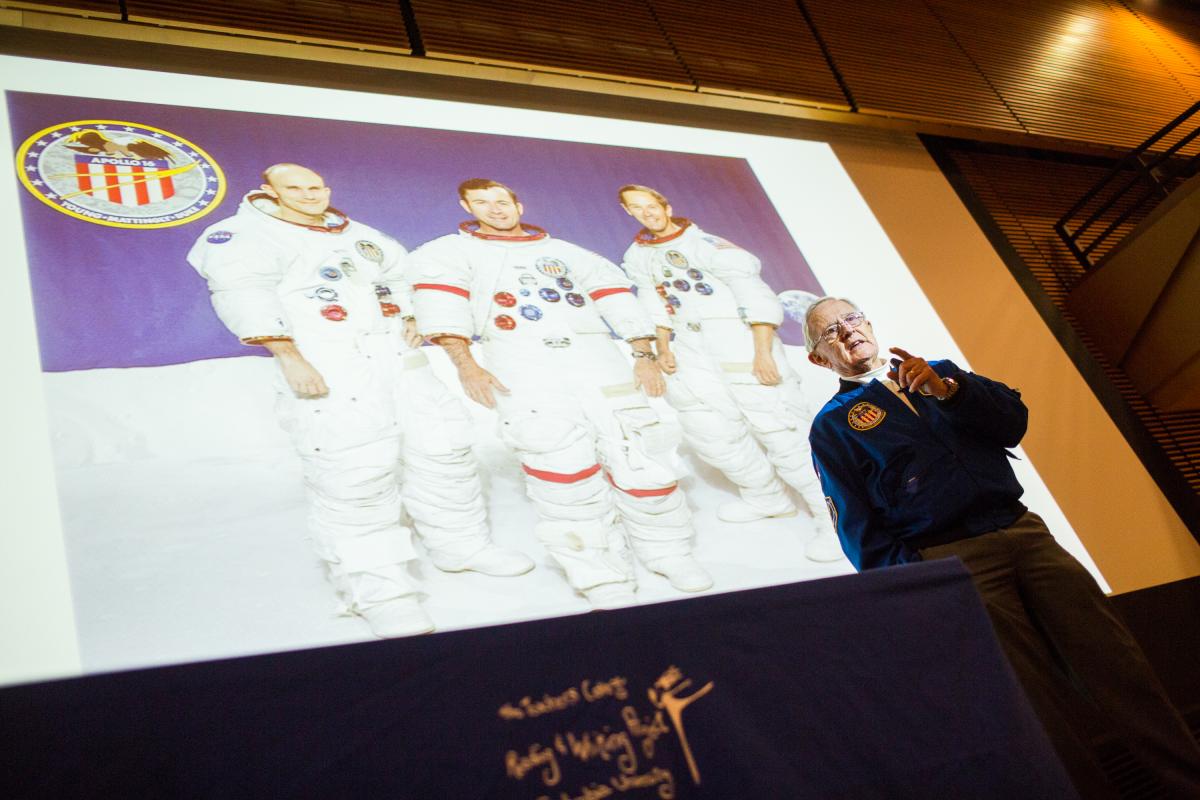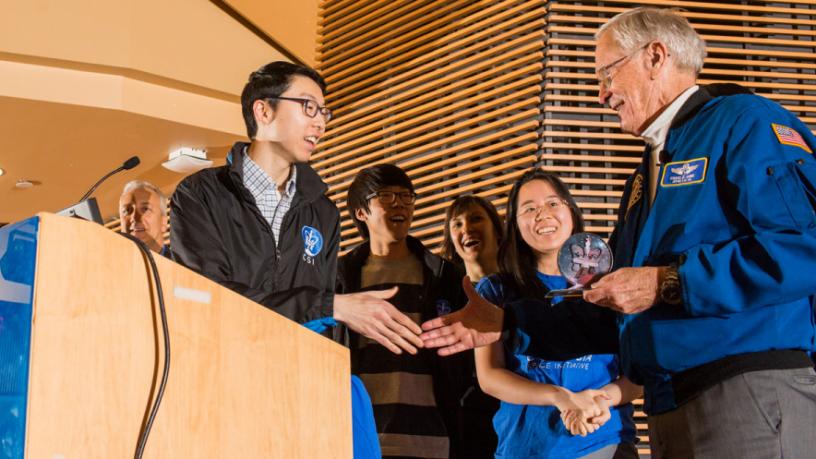Extreme Engineering: Tales From a Moonwalker
Astronaut Charlie Duke’s Visit Opens Columbia Engineering Week 2017
 TEST CAPTION TEXT
TEST CAPTION TEXT
Stepping onto the surface of the Moon, Apollo 16 astronaut Charlie Duke’s boots sunk about 2 centimeters into powder-like rock, leaving perfect outlines. He had landed in the lunar module Orion in a valley in the Descartes Highlands, slightly south of the Moon’s equator, on a mission to gather samples, conduct scientific experiments, and explore. Overhead, Earth hung in the blackness; the Sun was too bright to see any other stars.
“You never worry about getting lost on the Moon because you can always follow your tracks back to where you started,” Duke told a crowd at Columbia University last week, nearly 45 years after his moonwalk.
At 81, Duke is the youngest of the 12 humans who have ever set foot on the Moon, and one of just six still alive to tell the tale. The NASA legend was introduced at Columbia as “a true American hero” by fellow astronaut Mike Massimino, professor of professional practice in mechanical engineering and head of the Extreme Engineering lecture series.
On April 16, 1972, Lunar Module Pilot Duke launched into orbit aboard a Saturn V rocket alongside Commander John Young and Command Module Pilot Ken Mattingly. Reaching the moon via a special module, Duke and Young spent nearly three days on the surface and more than twenty hours out on moonwalks, including driving for miles in the lunar rover, or moon buggy, they’d brought along.
“We called it the ‘Grand Prix’,” Duke said. He noted that it’s difficult to judge distances on the Moon. “We had to be careful not to get stuck in a crater.”
It was a harsh environment—if his glove came off or his life support faltered, he was dead. The photo of his family that he left on the surface gradually degraded from the radiation. Still, the moonwalkers were sorry to have to leave.
“It was the most beautiful desert I’d ever seen,” Duke remembered. “It was very bright in the Sun, very dark in the shadows, and there was no sense of evil or danger.”
After blasting off from the Moon, they rendezvoused with the command module for the journey back home and had a successful splashdown (or “crashdown,” Duke quipped) in the Pacific Ocean 11 days after liftoff. Only one more mission, Apollo 17 later in 1972, has returned to the Moon since.
Now retired from NASA, Duke remains an avid ambassador for space exploration and commercialization. He would be happy to go up again, he says, but only with the prospect of coming back to Earth—so he’s given up on going to Mars, though he hopes someone makes it there soon.
“We always had such faith in Mission Control,” he said. “On Mars, you’re on your own. It’s 12 minutes to hear back from Houston.”
At the end of the evening, students from the Columbia Space Initiative presented Duke with an honorary T-shirt and 3D-printed version of the Columbia Space Initiative logo.
Duke’s visit was an early opener for Columbia Engineering Week 2017. Among the other events planned for Engineering Week:
- A second Extreme Engineering event was planned for Thursday, Feb. 23, with Victor Luo of NASA’s Jet Propulsion Laboratory. Luo has commanded Mars spacecraft and is working with augmented reality and other technologies for directing robots with simple body motions instead of complex controllers.
- A panel and networking event with Dean of Columbia Engineering Mary Boyce, the National Society of Black Engineers, the National Society of Hispanic Professional Engineers, and the Society of Women Engineers was also planned for Feb. 23.
- On Feb. 24, Massimino and Columbia Engineering students were invited to the Intrepid Sea, Air, and Space Museum to conduct a series of youth-oriented events.
- Engineering week wraps up with the MAKECU Hardware Hackathon over the weekend. Student and alumni events focusing on the creativity of engineering were also scattered throughout the week.

Columbia Space Initiative members James Gong CC'19, Jake Lee SEAS'19, Kristina Andreyeva SEAS'17, and Julia Di SEAS'18 present Charlie Duke with a 3D-printed CSI logo.
